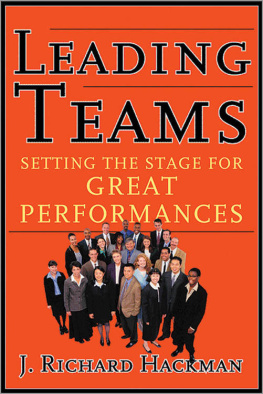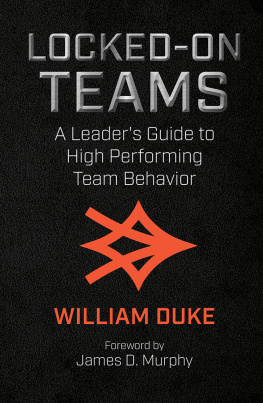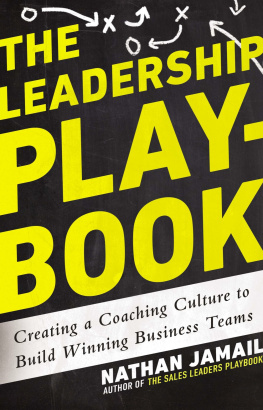Leading
Teams
Leading
Teams
SETTING THE STAGE
FOR GREAT
PERFORMANCES
J. Richard Hackman
HARVARD BUSINESS REVIEW PRESS
Boston, Massachusetts
Copyright 2002 Harvard Business School Publishing Corporation
All rights reserved
Requests for permission to use or reproduce material from this book should be directed to , or mailed to Permissions, Harvard Business School Publishing, 60 Harvard Way, Boston, Massachusetts 02163.
Library of Congress Cataloging-in-Publication Data
Hackman, J. Richard.
Leading Teams : setting the stage for great performances / J. Richard Hackman.
p. cm.
Includes bibliographical references and index.
ISBN 1-57851-333-2
1. Leadership. 2. Teams in the workplace. 3. Performance. I. Title.
HD57.7 .H336 2002
658.4092dc21
2002000757
Contents
Preface
Lets start with a pop quiz. Here are three items from a citizenship test given to all fourth-grade students in Ohio.
1. Which branch of Ohios state government makes laws?
a. Judicial
b. Executive
c. Legislative
2. Which of the following people is consuming something?
a. Carmen is walking her dog.
b. Jaleel is buying a new shirt.
c. Dale is sorting baseball cards.
3. When people work together to finish a job, such as building a house, the job will probably
a. get finished faster.
b. take longer to finish.
c. not get done.
Im fairly certain of the answer to the first item (the legislative branch) and the second (buying a shirt), which means that my knowledge of government and economics is at least at the fourth-grade level. But how about that third item? The Harvard student from Ohio who brought me the test said that alternative a (get finished faster) is scored as correct. But as she and I reflected on our own experiences in various kinds of work teams, we wondered about that. Too many of the teams we had been in barely worked at all.
There is a puzzle here. On the one hand, alternative a really should be the right answer. Work teams have more resources, and a greater diversity of resources, than do individual performers. Teams have great flexibility in how to deploy and use their resources. Teams provide a setting in which members can learn from one another and thereby build an ever-larger pool of knowledge and expertise. And there is always the possibility that a team will generate magicproducing something extraordinary, a collective creation of previously unimagined quality or beauty. These are significant benefits, and they help explain why teams are such a popular device for accomplishing organizational work these days.
On the other hand, team magic, as wondrous as it can be, is rarely seen. More commonly, teamwork really does take longer to finish (alternative b) or doesnt even get done at all (alternative c). When I announce on the first day of class that there will be group projects in my undergraduate course, there invariably are a few groans from students who have suffered through such projects in other courses. Moreover, research that compares the performance of teams with what is produced by an equivalent number of individuals who work by themselves almost always finds that the individuals outperform the teams.
This book seeks to resolve this puzzle, and do it in a way that can guide the actions of team leaders and members who seek to help their own teams perform welland maybe even generate a little magic now and then.
THE MAIN MESSAGE
Work teams perform poorly when leaders have focused on the wrong things in designing or supporting them. This book identifies what the right things arefive specific conditions that foster work team effectivenessand points to the right times to establish them. Although few in number, these conditions are great in impact. When leaders focus on creating and sustaining them, teams really can perform superbly.
The leaders main task, therefore, is to get a team established on a good trajectory and then to make small adjustments along the way to help members succeed, not to try to continuously manage team behavior in real time. No leader can make a team perform well. But all leaders can create conditions that increase the likelihood that it will.
There are better and worse times to intervene with teams. Certain acts of leadership are best done when a team is just starting out, others around the midpoint of a work cycle, and still others when a team has finished up a significant piece of work. Leadership initiatives that are done at the wrong times rarely make a constructive difference, and sometimes they backfire.
Anyone who succeeds in getting performance-enhancing conditions in place or helps strengthen them is exercising team leadership. That can be a person who is designated as team leader, to be sure. But it also can be a team member, an external manager, or even an outside consultant or client. It is not important who creates the conditions, how they go about doing it, or what their personality characteristics are. What is important is that the conditions that foster team effectiveness be put in place and stay there.
The five conditionshaving a real team, a compelling direction, an enabling team structure, a supportive organizational context, and expert team coachingare easy to remember. The challenge comes in developing an understanding of those conditions that is deep and nuanced enough to be useful in guiding action, and in devising strategies for creating them even in demanding or team-unfriendly organizational circumstances. People who are natural team leaders seem to know intuitively how to do these things. In this book, I have attempted to capture what natural leaders know, integrate that with social science research findings about team behavior, and generate a set of lessons that leaders can use to set the organizational stage for great team performances.
ABOUT THE BOOK
If I have achieved my aspiration in writing this book, four different groups of readers will find it informative and useful: (1) practitioners who want to help the teams they lead, or on which they serve, perform as well as possible; (2) scholars who conduct research on team behavior and performance who seek fresh ways of thinking about the factors that most powerfully shape team effectiveness; (3) consultants who may find it useful to inspect and analyze teams through a somewhat unconventional lens; and (4) general readers who are curious about why it is that some teams sail into orbit while others either struggle unpleasantly to an unsatisfactory outcome or crash and burn shortly after launch.
Although the assertions and conclusions in the book are grounded in up-to-date research and theory about work team behavior and performance, Ive done my best to avoid the use of academic and management jargon (the term empowerment, for example, is used but once in the entire book, and that time reluctantly). Instead, I have tried to use language, concepts, and extended examples that make the material as engaging, concrete, and useful as possible.
The book is optimistic about what team leaders can accomplish. Providing first-rate team leadership unquestionably is a significant personal and organizational challenge. But good team leadership really does make a difference. I reject the views of some contemporary scholars that leadership is mainly a symbolic activity of no real consequence, that leaders are but pawns in larger dramas driven by external forces, and that the best that high-status leaders can hope to do is compose a team well and then keep their distance to avoid unduly influencing members deliberations. Instead, I have attempted to lay out a way of thinking about team leadership that can increase leaders leverage in helping a team perform superbly and, in the process, become stronger over time as a performing unit and contribute positively to the personal learning and well-being of individual members.
Next page







